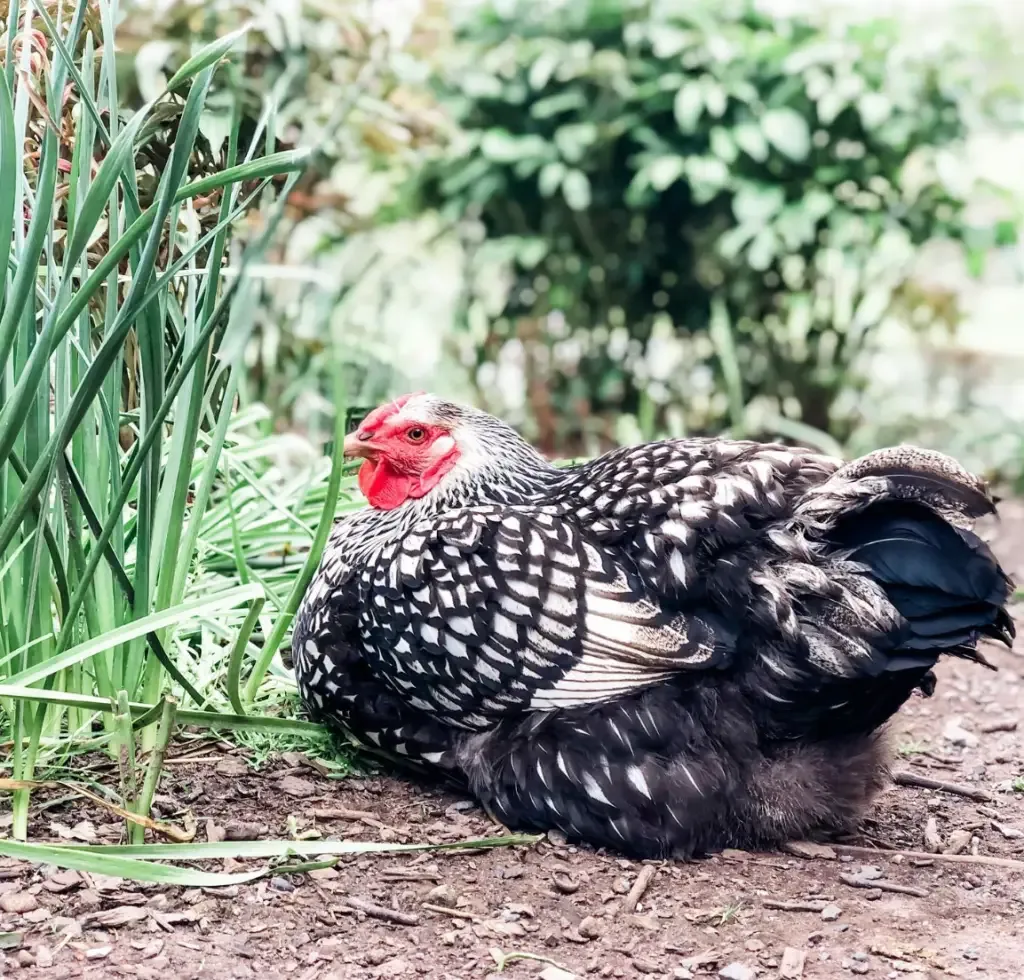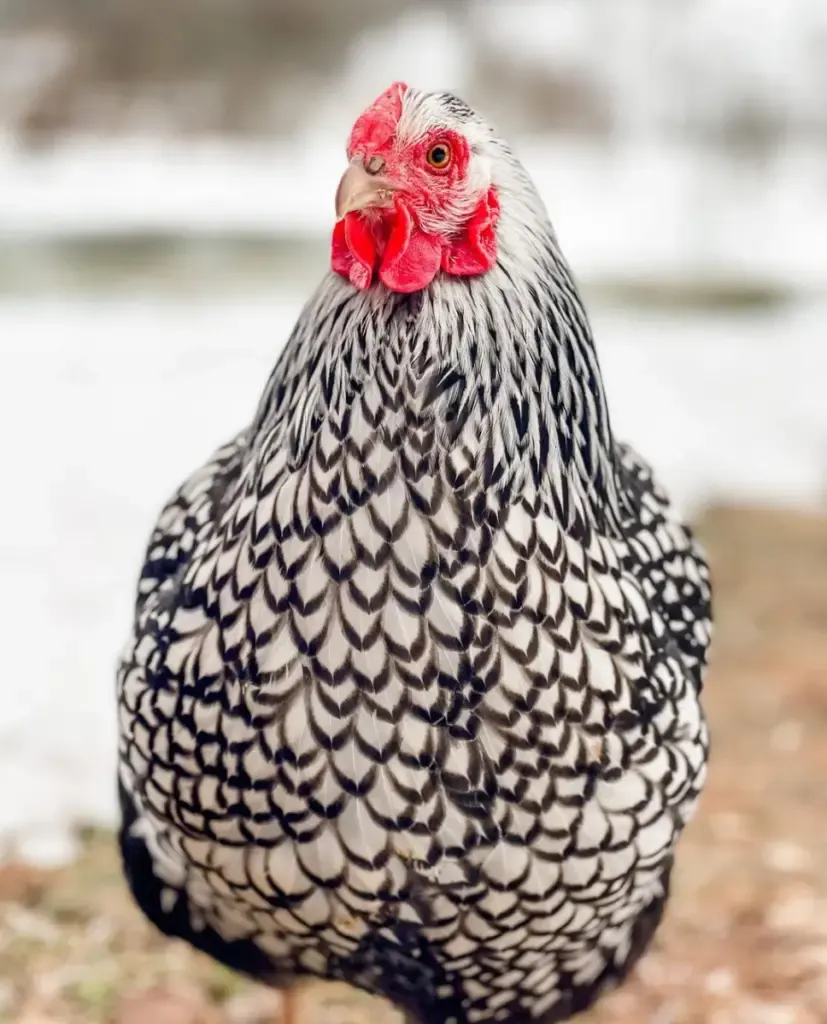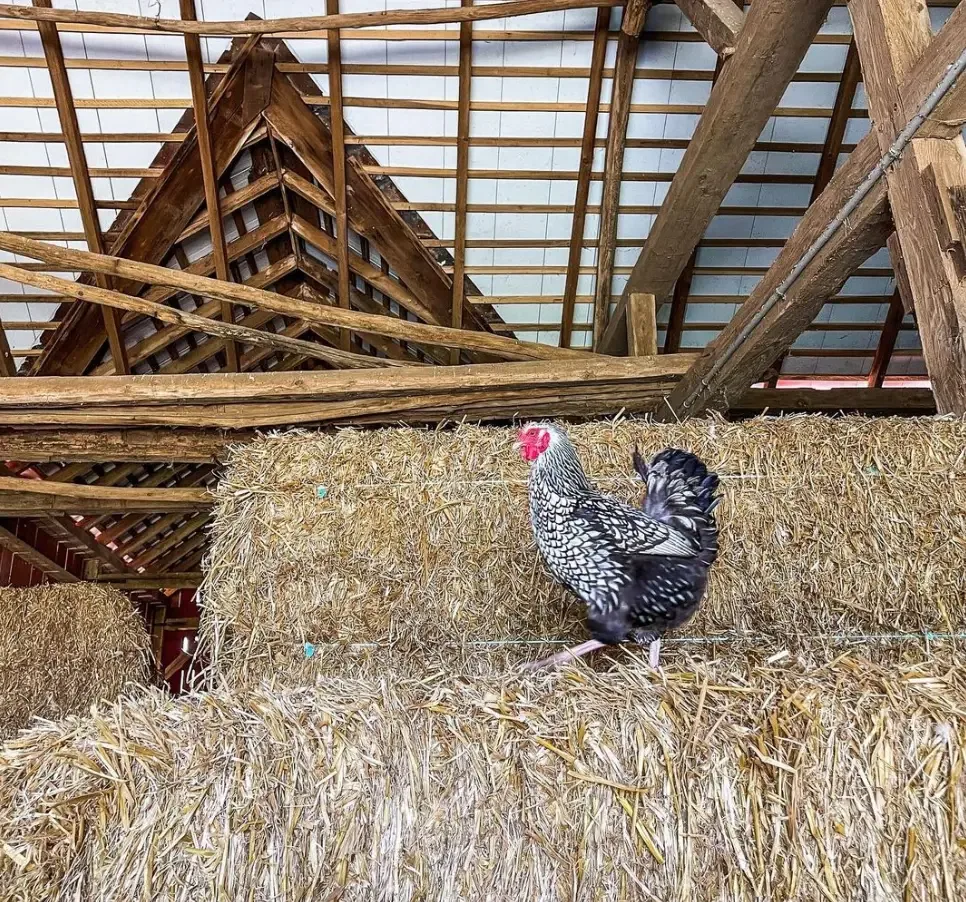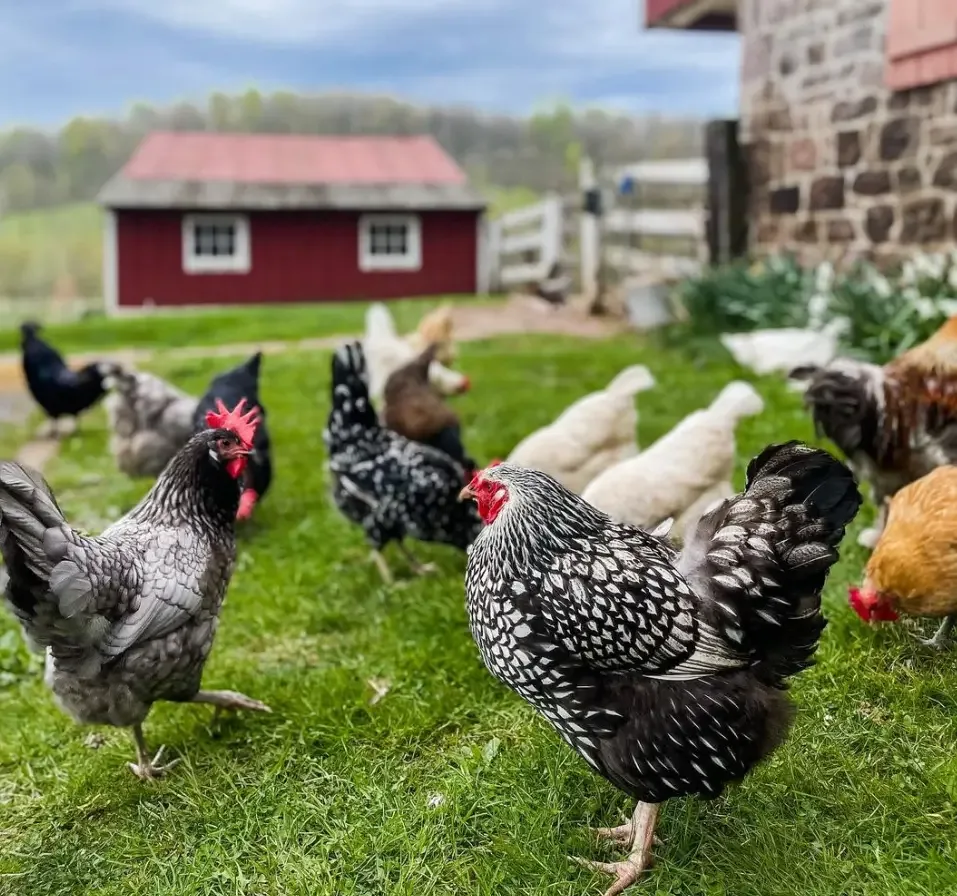The Silver Laced Wyandotte is a stunning breed of chicken that is highly sought after by both backyard chicken keepers and exhibition breeders.
This breed is known for its beautiful black and silver feather pattern, bright red combs and wattles, and friendly temperament.
The Silver Laced Wyandotte is also a great egg layer, making it a popular choice for those who want both beauty and functionality in their backyard flock.
Overall, the Silver Laced Wyandotte is an excellent choice for those who want a beautiful, friendly, and productive breed of chicken in their backyard flock.
In this article, we will discuss:
- Silver Laced Wyandotte origin and history
- The physical characteristics of Silver Laced Wyandotte chickens
- Their personality and temperament
- Silver Laced Wyandotte care requirements and health concerns
- And some frequently asked questions

Silver Laced Wyandotte Overview
| Lifespan | 6+ years |
| Weight | Hen: 6-7 lbs, Rooster: 8-9 lbs |
| Appearance | Black, silver, and white feathers |
| Egg Color | Brown or cream |
| Egg Size | Medium |
| Egg Production | 200-220 per year (4-5 per week) |
| Broodiness Level | Medium |
| Beginner Friendly | Yes |
| Space Needed | 4 square feet per bird inside the coop, 10 square feet each outdoors |
| Price | $3-$5 per chick |
Origin and History
Developed in the United States over a century ago, the Silver Laced Wyandotte is the original variety of the Wyandotte chicken.
Other varieties were later developed from this breed with crosses from other breeds.
Despite being listed as a ‘priority’ breed by the ALBC until 2016, the Silver Laced Wyandotte has recovered enough in numbers to no longer be considered threatened.
However, its popularity continues to grow due to its stunning appearance and excellent egg-laying abilities.
The Silver Laced Wyandotte is a historic North American breed that has been around for over a century.
This breed was developed in the United States, and its exact origins are unknown.
However, genetic material from dark Brahmas and silver-spangled Hamburgs are likely contributors to the breed.
Breda and Polish fowl were also possible contributors to the genetic pool.
Founding of the Breed
The definitive history of the American Wyandotte chicken breed is unknown. It started as a chicken type with no name attributed to it, although it was common in many barnyards.
In the late 1800s, a group of breeders in New York and New Jersey began to refine the breed. They wanted to create a chicken that was hardy, dual-purpose, and had attractive plumage.
The breeders crossed various breeds, including the Brahma, Hamburg, Cochin, and Plymouth Rock, to create the Wyandotte.
The Silver Laced Wyandotte was one of the first varieties of Wyandotte to be developed and it was created by crossing silver-spangled Hamburgs with dark Brahmas.
The breeders then crossed the resulting birds with white Cochins and partridge Cochins to create the gold-laced and buff varieties.
The black variety was also a sport of both the silver-laced and gold-laced varieties.
Silver Laced Wyandotte Breed Standard
The Wyandotte breed was recognized by the American Poultry Association in 1883, and it quickly became popular among poultry keepers.
The breed’s popularity peaked in the early 1900s, and it was one of the most widely kept breeds in the United States.
Silver Laced Wyandotte chickens were particularly popular, and it was known for their beautiful plumage and excellent egg-laying abilities.
Today, the Silver Laced Wyandotte remains a popular breed among poultry keepers.
It is still recognized by the American Poultry Association and is considered a heritage breed.
The breed is known for its hardiness, dual-purpose nature, and attractive plumage. It is a great choice for backyard flocks and small-scale egg production.

Appearance
The Silver Laced Wyandotte is an attractive bird with a beautiful feather pattern.
Their feathers are silver and white, with black lacing around the edges and their tail feathers are mostly black.
They have a tight rose comb and yellow skin underneath their abundance of fluffy feathers.
The American Poultry Association has recognized only 8 varieties of Wyandotte breed, including Silver Laced Wyandotte.
Size & Weight
The Silver Laced Wyandotte is a large breed of chicken, with hens weighing in at around 6-7 pounds and roosters weighing approximately 8-9 pounds.
They have a broad, rounded body shape and short, stocky legs.
This breed also comes in bantam size that weighs around 3-4 pounds each.

Personality and Temperament
The Silver Laced Wyandotte is known for its friendly and docile personality, making it a great choice for backyard chicken owners who want a breed that is easy to handle.
They are also very curious birds and enjoy exploring their surroundings while free ranging and roaming.
This breed is often defined as:
- Easy-going
- Docile
- Friendly
- Curious
- Non-aggressive
Keep in mind that while they are generally calm and gentle, individual birds can have different personalities.
Some Silver Laced Wyandottes may be more assertive or independent than others, so it is important to observe each bird’s behavior and personality to determine its individual needs.
In terms of their interaction with other birds, Silver Laced Wyandottes are known for their peaceful nature.
They are not aggressive and will not start fights with other birds. However, they are not pushovers and will defend themselves if necessary.
They should be kept with birds with the same personality type to avoid bullying and aggression towards them.
Egg Production
Silver Laced Wyandottes are known for their excellent egg-laying capabilities.
They can lay between 200-220 eggs per year (4-5 eggs per week), which is a good number for a dual-purpose breed.
However, the exact number of eggs they lay depends on various factors such as diet, age, and environment.
It is important to note that the laying capacity of Silver Laced Wyandottes tends to decrease as they age.
They are most productive in their first year of laying, and their egg production gradually declines after that.
However, with proper care and nutrition, they can continue to lay eggs for several years.
Egg Color
The eggs laid by Silver Laced Wyandottes are medium-sized and have brown or cream shells.
The color of their eggs is not as dark as some other breeds, but it is still a desirable shade for many people. The exact color of the eggs can vary slightly depending on the individual hen.
It is worth mentioning that the egg color of Silver Laced Wyandottes can change slightly depending on the season.
During the winter months, their eggs may be lighter in color due to the reduced sunlight. However, this is a normal and natural occurrence, and the egg quality remains the same.
Silver Laced Wyandotte Lifespan
Silver Laced Wyandottes have an average lifespan of 6-8 years.
However, with proper care and management, they can live up to 10 years or more.
Factors that can affect their lifespan include genetics, diet, environment, and disease prevention.
To ensure a long and healthy life for your Silver Laced Wyandottes, provide them with a balanced diet, clean water, and a clean and spacious living environment.
Regular health checks and prompt treatment of any health issues can also help prolong their lifespan.

Silver Laced Wyandotte Care and Maintenance
When it comes to caring for Silver Laced Wyandottes, there are a few things to keep in mind to ensure that they stay healthy and happy.
This section will cover the feeding requirements, housing needs, and health concerns of these chickens.
Feeding
Silver Laced Wyandottes are not picky eaters and will happily eat a variety of foods.
However, it’s important to ensure that they are getting the right balance of nutrients in their diet.
A good quality layer feed is recommended, as it contains the right amount of protein, vitamins, and minerals that these chickens need to lay eggs and maintain their health.
In addition to layer feed, it’s a good idea to offer your Silver Laced Wyandottes some treats, such as fruits, vegetables, high-calcium snacks, and high-protein sources like mealworms or black fly larvae.
The additional protein and calcium will allow them to lay eggs with stronger shells.
Additionally, they can eat fruits like watermelon, kiwis, and pineapple, as well as vegetables such as celery, green beans, lettuce, and other leafy greens.
These treats should be given in moderation, as too many can upset the balance of their diet.
A good rule of thumb is to feed them mostly high-quality commercial feed with only 10%-20% of their overall diet being treats, snacks, and table scraps.
It’s also important to ensure that your chickens have access to clean water at all times.
Housing Needs
Silver Laced Wyandottes are relatively easy to care for and can adapt to a variety of living conditions.
However, it’s important to provide them with a safe and comfortable living space. A coop that is well-ventilated, dry, and draft-free is essential.
The coop should also be predator-proof, as these chickens are vulnerable to attacks from predators such as foxes and raccoons.
When it comes to space requirements, each chicken should have at least 4 square feet of indoor space and 10 square feet of outdoor space.
It’s also important to provide them with perches for roosting, nesting boxes for laying eggs, and litter for absorbing moisture and keeping the coop clean.
Health Concerns
Silver Laced Wyandottes are generally healthy and hardy birds, but like any other breed, they are still prone to some common health issues.
Here are some of the most common health problems that Silver Laced Wyandottes may experience:
- Respiratory Infections: These infections can be caused by bacteria, viruses, or fungi. Symptoms include coughing, sneezing, nasal discharge, and difficulty breathing. Good ventilation and cleanliness in the coop can help prevent respiratory infections.
- Mites and Lice: These parasites can cause feather loss, skin irritation, and anemia. Regular dust baths and cleaning of the coop can help prevent infestations.
- Egg Binding: This occurs when an egg gets stuck in the hen’s reproductive tract. Symptoms include lethargy, straining, and a swollen abdomen. Providing calcium supplements and ensuring that the hen has access to plenty of water can help prevent egg binding.
It’s important to check your chickens often for any signs of health issues.
Failure to notice and treat any of these health issues promptly can result in long-term health problems or death in severe circumstances.
Breeding Silver Laced Wyandotte
Breeding Silver Laced Wyandotte can be a rewarding experience for those interested in raising poultry.
Before starting, it is important to have a clear understanding of the breeding requirements and incubating and hatching.
Breeding Requirements
When breeding Silver Laced Wyandotte, it is important to select healthy and genetically diverse breeding stock.
This will help to prevent inbreeding and maintain the breed’s genetic diversity.
It is recommended to use a breeding ratio of one rooster to ten hens to ensure a good hatch rate.
Silver Laced Wyandotte hens are good layers and can produce up to 220 eggs per year.
They are also known to be good mothers and can raise their chicks without much intervention.
When breeding, it is important to provide a suitable nesting box for the hens to lay their eggs.
Incubation and Hatching Silver Laced Wyandottes
Silver Laced Wyandotte eggs take around 21 days to hatch.
When incubating, it is important to maintain a consistent temperature of around 99.5°F and a humidity level of around 50% to 60%. It is also important to turn the eggs regularly to prevent the embryos from sticking to the shell.
Once the chicks hatch, it is important to provide them with a warm and dry environment.
A brooder box with a heat lamp can be used to keep the chicks warm. It is also important to provide them with clean water and chick starter feed.
Overall, breeding Silver Laced Wyandotte can be a rewarding experience for those interested in raising poultry.
By selecting healthy and genetically diverse breeding stock and providing a suitable environment for incubation and hatching, breeders can help to maintain the breed’s genetic diversity and ensure the health and well-being of their birds.
Role in Sustainable Farming
The Silver Laced Wyandotte is a versatile breed that plays an important role in sustainable farming.
They are a dual-purpose breed, meaning they are suitable for both meat and egg production.
This makes them an excellent choice for small-scale farmers who want to raise their own food.
Their hardiness and adaptability make them an ideal breed for free-range and pasture-based farming systems.
They are able to forage for a significant portion of their diet, which can reduce feed costs and increase the sustainability of the farm. They are also cold-hardy, making them suitable for colder climates.
Overall, the Silver Laced Wyandotte is a valuable breed for sustainable farming systems. Their dual-purpose nature, adaptability, and striking appearance make them a popular choice for small-scale farmers and backyard flock owners alike.
Final Thoughts
Silver Laced Wyandotte chickens are a well-rounded breed with an abundance of great qualities.
With their calm and friendly temperament, hardy nature, and striking appearance, it’s no wonder this breed is popular.
If you’re considering adding Silver Laced Wyandottes to your flock, be sure to do plenty of research to find a reputable breeder to ensure that you’re getting healthy and well-cared-for birds.
Still not sure? Keep reading below for some frequently asked questions.
Frequently Asked Questions
What is the temperament of Silver Laced Wyandottes?
Silver Laced Wyandottes are known for their calm and friendly temperament.
They are easy to handle and enjoy human interaction, making them a great choice for beginners.
They are also good with other chickens and can adapt well to different environments.
Are Silver Laced Wyandottes good egg layers?
Silver Laced Wyandottes are moderate egg layers, typically laying around 200-220 brown eggs per year (4-5 eggs per week).
However, this can vary depending on factors such as diet, age, and environment.
What is the lifespan of Silver Laced Wyandottes?
Silver Laced Wyandottes have a lifespan of around 5-8 years, with proper care and nutrition.
However, this can vary depending on genetics and environmental factors.
What colors do Silver Laced Wyandottes come in?
Silver Laced Wyandottes come in one color variety, which is silver-white plumage with black edging.
This gives them a distinctive lacy appearance, which is where their name comes from.
What is the difference between Silver Laced Wyandottes and Silver Laced Orpingtons?
While both breeds have silver laced plumage, Silver Laced Wyandottes are smaller and more compact than Silver Laced Orpingtons.
They also have a rose comb, while Orpingtons have a larger, single comb.
In terms of temperament, Wyandottes are generally more active and independent, while Orpingtons are more docile and friendly.
What is the rarest Wyandotte chicken breed?
The rarest Wyandotte chicken breed is the Blue Laced Red Wyandotte.
This breed has a striking blue and red feather pattern, but is difficult to breed due to its complex genetics.
As a result, it is relatively rare and sought after by chicken enthusiasts.

